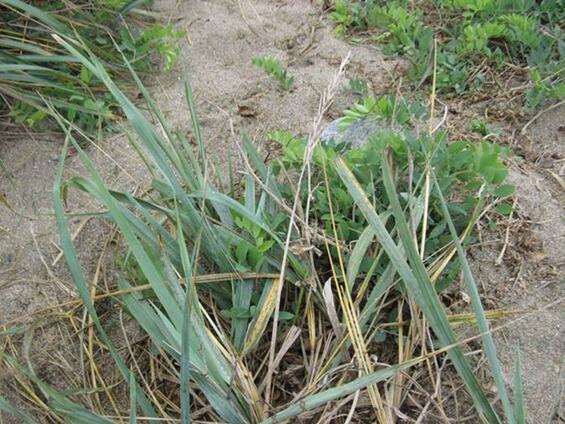- Scientific name: Leymus mollis
- Species of Greatest Conservation Need (MA State Wildlife Action Plan)
- Endangered (MA Endangered Species Act)
Description

Sea lyme-grass is a robust perennial grass (family Poaceae) of seaside dunes, with glaucous leaves and a stout, dense-flowering spike. It grows in clumps above the high tide line, originating from long, robust rhizomes that spread out under the sand, anchoring the grass and stabilizing dunes.
Sea lyme-grass ranges from 50-150 cm in height (20-60 in). The stem is hairy beneath the inflorescence, which is a spike. The spike is dense, 1-2 cm (0.3-0.75 in) wide, and 10-30 cm (4-12 in) long, surpassing the foliage. Spikelets are arranged two per node, with each bearing three to six florets. The glumes and lemmas are pubescent. A fine, waxy coating gives the plant a whitish (glaucous) tinge, as on a cabbage leaf. The 6-15 mm (0.24-0.59 in) wide leaves are crowded at the bottom of the stem with their lower parts overlapping as they sheath the stem.
The widespread Beach Grass (Ammophila breviligulata), a frequent associate, is not glaucous, and has narrower leaf blades (4-8 mm; 0.16-0.31 in). In addition, the inflorescence is compact but branched (i.e., a panicle, not a spike), and the spikelets have only one floret.
Life cycle and behavior
This is a perennial species.

Population status
Sea lyme-grass is listed under the Massachusetts Endangered Species Act as Endangered. All listed species are protected from killing, collecting, possessing, or sale and from activities that would destroy habitat and thus directly or indirectly cause mortality or disrupt critical behaviors. The Massachusetts Natural Heritage & Endangered Species Program has 5 records from 4 counties: Barnstable, Dukes, Essex, and Nantucket. 2 of these records have been observed within the last 25 years.
Distribution and abundance
Distributed on coasts from Iceland to eastern Asia. In North America, it is found on the northern Pacific and Atlantic coasts south to Massachusetts and California as well as the Arctic coast. Sea lyme-grass also occurs on the shores of the Great Lakes.

Distribution in Massachusetts. 2000-2025. Based on records in the Natural Heritage Database.
Habitat
Sea lyme-grass is found on sandy beaches, often just above the highest high tide line and usually seaward from Beach Grass. Other associates include beach pea (Lathyrus japonica), poison ivy (Toxicodendron radicans), rugosa rose (Rosa rugosa), staghorn sumac (Rhus typhina), seaside goldenrod (Solidago sempervirens), ragweeds (Ambrosia spp.), and mustards (Brassica spp.).
Healthy habitats are vital for supporting native wildlife and plants. Explore habitats and learn about conservation and restoration in Massachusetts.
Threats
Trampling by foot traffic or off-road vehicles, scouring by storm surges, beach erosion, and competition from non-native and native plants due to fire exclusion are the major threats to this species. Sites where dunes are unable to migrate landward in response to sea level rise are particularly vulnerable.
Conservation
Locations that receive heavy recreational use should be carefully monitored for plant damage or soil disturbance. Trails near any sea lyme-grass populations should be re-routed and informal trails should be blocked with fencing or signage. Sites should be evaluated for the need for beach stabilization through planting of other dune species. Sites should be monitored for competition from exotic plants and aggressive or tall native plants; if exotic or native plants are crowding and outcompeting this species, a plan should be developed, in consultation with MassWildlife’s Natural Heritage & Endangered Species Program (NHESP), to remove the competitors. All active management of rare plant populations (including invasive species removal) is subject to review under the Massachusetts Endangered Species Act and should be planned in close consultation with NHESP.
Contact
| Date published: | April 30, 2025 |
|---|